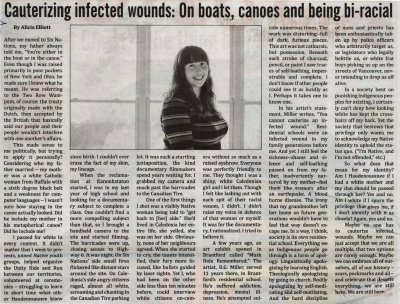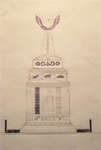"Cauterizing infected wounds: On boats, canoes and being bi-racial"
- Publication
- Two Row Times (Six Nations of the Grand River, ON), 13 May 2015
- Full Text
- Cauterizing infected wounds: On boats, canoes and being bi-racialBy Alicia Elliott
After we moved to Six Nations, my father always told me, "You're either in the boat or in the canoe." Even though I was raised primarily in poor pockets of New York and Ohio, he made sure I knew what he meant. He was referring to the Two Row Wampum, of course: the treaty originally made with the Dutch, then accepted by the British that basically said our people and their people wouldn't interfere with one another's affairs.
This made sense to me politically, but trying to apply it personally? Considering who my father married - my mother was a white Catholic woman from Buffalo with a sixth degree black belt and a weakness for computer languages - I wasn't sure how staying in the canoe actually looked. Did he include my mother in his metaphorical canoe? Did he include me?
I passed for white in every context. It didn't matter that l went to protests, joined Native youth groups, helped organize the Unity Ride and Run between our territories, volunteered at ceremonies struggling to learn in short time what other Haudenosaunee knew since birth. I couldn't ever erase the fact of my skin, my lineage.
When the reclamation at Kanonhstaton started, I was in my last year of high school and looking for a documentary subject to complete a class. One couldn't find a more compelling subject than that, so I brought a handheld camera to the site and started filming. The barricades were up, closing access to Highway 6. It was night. On Six Nations' side small fires flickered like distant stars around the site. On Caledonia's side angry citizens raged, almost all white, screaming and chanting in the Canadian Tire parking lot. It was such a startling juxtaposition, the kind documentary filmmakers spend years waiting for. I grabbed my camera and snuck past the barricades to the Canadian Tire.
One of the first things I shot was a visibly Native woman being told to "get back to [her] side." She'd lived in Caledonia her entire life, she yelled, she was on her side. Obviously, none of her neighbours agreed. When she started to cry, the taunts intensified, their fury more focused, like bullets guided by laser sights. Yet I, who had been on the other side less than ten minutes before, could interview white citizens on-camera without so much as a raised eyebrow. Everyone was perfectly friendly to me. They thought I was a shiny, white Caledonian girl and I let them. Though I felt like lashing out with each spit of their racist venom, I didn't. I didn't raise my voice in defence of that woman or myself. It was for the documentary, I rationalized. I tried to believe it.
A few years ago, an art exhibit opened in Brantford called "Mush Hole Remembered." The artist, R.G. Miller, served 11 years there, in Brantford's residential school. He's suffered addiction, depression, mental illness. He's attempted suicide numerous times. The work was disturbing full of dark, furious pieces. This art was not catharsis, but possession. Beneath each stroke of charcoal; pencil, or paint I saw traces of self-loathing, impenetrable and complete. I don't know if other people could see it as lucidly as I. Perhaps it takes one to know one.
In his artist's statement, Miller writes, "You cannot cauterize an infected wound." Residential schools were an infected wound in my family generations before me. And yet I still feel the sickness -shame and silence and self-loathing passed on from my father, inadvertently nurtured by my mother - feel them like tremors after an earthquake. A blood borne disease. The irony that my grandmother left her home so future generations wouldn't have to feel that way doesn't escape me. In a way, I think, society is its own residential school. Everything we as Indigenous people go through is a form of apology. Linguistically apologizing by learning English. Theologically apologizing by going to church. Bodily apologizing by self-medicating and self-mutilating. And the hard discipline of nuns and priests has been enthusiastically taken up by police officers who arbitrarily target us, or legislators who legally belittle us, or white frat boys picking us up on the streets of Vancouver, never intending to drop us off alive.
In a society bent on punishing indigenous peoples for existing, I certainly can't deny how looking white has kept the crosshairs off my back. Yet the society that bestows that privilege only wants me to acknowledge my Native identity to uphold the status quo. ("I'm Native, and I'm not offended," etc.)
So what does that mean for my identity? Am I Haudenosaunee if I had a white mother and my clan should be passed through her? Yes and no. Am I white if I spurn the privilege that gives me, if I don't identify with it as closely? Again, yes and no.
Maybe no one has to cauterize infected wounds. Maybe we can just accept that we are all multiple, that two options are rarely enough. Maybe we can embrace all of ourselves, all of our history - scars, pockmarks and all - and celebrate that despite everything, we are still here. We are still here.
- Creator
- Elliott, Alicia, Author
- Media Type
- Text
- Newspaper
- Item Type
- Clippings
- Publisher
- Two Row Times
- Place of Publication
- Six Nations of the Grand River, ON
- Date of Publication
- 13 May 2015
- Subject(s)
- Personal Name(s)
- Miller, R.G.
- Corporate Name(s)
- Canadian Tire.
- Local identifier
- SNPL004470v00d
- Language of Item
- English
- Creative Commons licence
 [more details]
[more details]- Copyright Statement
- Public domain: Copyright has expired according to Canadian law. No restrictions on use.
- Copyright Date
- 2015
- Copyright Holder
- Two Row Times
- Contact
- Six Nations Public LibraryEmail:info@snpl.ca
Website:
Agency street/mail address:1679 Chiefswood Rd
PO Box 149
Ohsweken, ON N0A 1M0
519-445-2954



